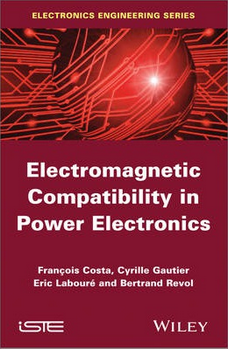
Electromagnetic Compatibility in Power Electronics
[BOOK DESCRIPTION]
Scientists largely attribute the recent deterioration of the electromagnetic environment to power electronics. This realization has spurred the study of methodical approaches to electromagnetic compatibility designs as explored in this text. The book addresses major challenges, such as handling numerous parameters vital to predicting electro magnetic effects and achieving compliance with line-harmonics norms, while proposing potential solutions.
[TABLE OF CONTENTS]
Chapter 1 Phenomena of Perturbation in 1 (74)
Electrical Systems
1.1 Electromagnetic perturbations in 1 (5)
energy systems
1.1.1 Introduction 1 (5)
1.2 Power grid harmonics 6 (23)
1.2.1 Presentation 6 (2)
1.2.2 Characterization of the quality 8 (2)
of electrical energy
1.2.3 Relevant standards for harmonic 10 (1)
emissions
1.2.4 Classification of appliances 11 (1)
1.2.5 The limits of harmonic currents 12 (3)
1.2.6 Examples of observations of 15 (1)
harmonic currents
1.2.7 Fluorescent lighting scenario 16 (4)
1.2.8 Practical scenario of the 20 (4)
improvement of the total harmonic
distortion generated by a
variable-frequency drive
1.2.9 Converter with sinusoidal 24 (5)
absorption
1.3 Common-mode and differential-mode 29 (15)
conducted perturbations
1.3.1 Common mode and differential mode 30 (11)
1.3.2 Crosstalk 41 (3)
1.4 Measuring electromagnetic 44 (28)
perturbations
1.4.1 The line impedance stabilization 44 (2)
network
1.4.2 Current sensors 46 (7)
1.4.3 Antennae 53 (12)
1.4.4 Spectrum analyzer 65 (7)
1.5 The standards 72 (1)
1.6 Bibliography 73 (2)
Chapter 2 Fundamental Principles 75 (68)
2.1 Sources of noise: the switching cell 75 (2)
and its control
2.1.1 Origin of conducted and radiated 76 (1)
perturbations in static converters
2.2 Modeling 77 (9)
2.2.1 Simple model of the switching cell 77 (5)
2.2.2 More complex model of the 82 (4)
switching cell
2.3 Characterization of coupling 86 (17)
functions and parasitic elements
2.3.1 Passive components and 86 (3)
differential-mode effects
2.3.2 Invisible parasitic elements and 89 (2)
common-mode effects
2.3.3 Parasitic effects contributing to 91 (12)
undesirable couplings
2.4 Electromagnetic compatibility study 103(11)
of a practical scenario: the Buck chopper
2.4.1 Description of the case study 104(5)
2.4.2 Influence of the design 109(2)
parameters of the converter
2.4.3 Influence of technological 111(1)
parameters and control
2.4.4 Other sources of switching noise 112(1)
2.4.5 Other switching modes: soft 113(1)
switching, advantages and constraints
2.5 EMC study of an insulated DC-DC fly 114(13)
back power supply
2.5.1 Description of the device 114(3)
2.5.2 Creation of the circuit model 117(4)
2.5.3 Analysis of switchings in the 121(2)
structure
2.5.4 Electric simulation of the 123(4)
complete structure
2.6 Corrected exercise number 1: 127(3)
conducted perturbations of a step-up
chopper
2.7 Answers with comments 130(11)
2.8 Bibliography 141(2)
Chapter 3 EMC of Complex Electrical Energy 143(64)
Conversion Systems: Electromagnetic
Actuators
3.1 How to define a complex system? 143(2)
3.2 Qualitative study 145(7)
3.2.1 Description of the conversion 145(2)
chain
3.2.2 Reminder of the standards 147(2)
3.2.3 Propagation methods 149(3)
3.3 Modeling in frequency domain 152(21)
3.3.1 Linearization of the switching 152(5)
cell
3.3.2 Modeling of the perturbation 157(16)
sources
3.4 Frequency-based representation of an 173(6)
inverter
3.4.1 Equivalent common-mode source - 173(3)
simplified diagram
3.4.2 Differential-mode influence 176(2)
3.4.3 Proposed frequency-based diagram 178(1)
3.5 Modeling of the cables and motors 179(17)
3.5.1 Estimation of the primary 179(6)
parameters of the power cables
3.5.2 High-frequency model of an 185(11)
asynchronous machine
3.6 Connection of the cable and the motor 196(2)
3.6.1 Total impedance read by the 196(1)
variable-speed drive
3.6.2 Measuring the total common-mode 197(1)
impedance
3.7 Results 198(3)
3.7.1 Time-based simulation and 198(2)
frequency-based simulation
3.7.2 Measurement versus simulation 200(1)
3.8 Passing from the time domain to the 201(3)
frequency domain: circuit simulations
3.9 Conclusion 204(1)
3.10 Bibliography 205(2)
Chapter 4 Concrete Study of Solutions for 207(72)
the Reduction of Electromagnetic
Perturbations
4.1 Concrete study of solutions for the 207(5)
reduction of electromagnetic perturbations
4.1.1 Introduction 207(5)
4.2 Filtering conducted emissions: 212(9)
analysis and conceptual design of
common-mode filters
4.2.1 Introduction 212(2)
4.2.2 Description of a common-mode 214(7)
filter
4.3 Case study: determining a common-mode 221(9)
filter for a variable-speed drive
4.3.1 Equivalent model of the drive 221(2)
4.3.2 Filter simulated using perfect 223(3)
components
4.3.3 Effect of the parasitic elements 226(4)
of components
4.4 Design and optimization components 230(9)
4.4.1 Study of capacitors 230(2)
4.4.2 Study of the common-mode toric 232(5)
inductance
4.4.3 Results 237(2)
4.5 Conclusion 239(9)
4.5.1 Corrected exercise: filtering the 239(9)
conducted perturbations of a step-up
chopper
4.6 Shielding 248(27)
4.6.1 Introduction 248(1)
4.6.2 Breakdown of shielding effects 249(3)
4.6.3 Materials 252(5)
4.6.4 Wave impedance 257(7)
4.6.5 Expression of attenuations 264(5)
4.6.6 Global attenuation: case study 269(4)
4.6.7 Shielding issues for magnetic 273(2)
fields in low frequency
4.7 Conclusion 275(1)
4.8 Bibliography 276(3)
Index 279

 新书报道
新书报道